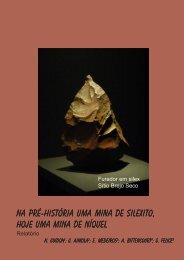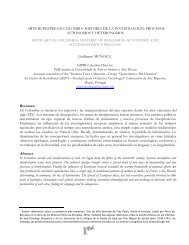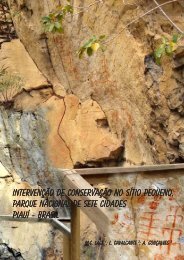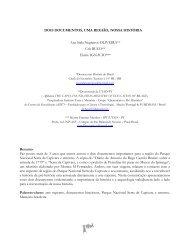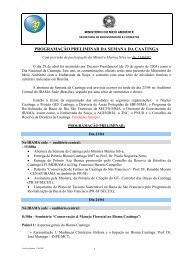Untitled - Fundação Museu do Homem Americano
Untitled - Fundação Museu do Homem Americano
Untitled - Fundação Museu do Homem Americano
Create successful ePaper yourself
Turn your PDF publications into a flip-book with our unique Google optimized e-Paper software.
Global Rock Art Congress<br />
29 Junho – 3 de Julho 2009<br />
Astronomical Views and Symbolism in Rock Art of Japan, with Reference to Effective<br />
Managements of Rock Art by <strong>Museu</strong>ms (Especially Of Chambered Tombs).<br />
Nobuhiro Yoshida, Japão<br />
The most understandable and intelligible concrete imagery of astronomy, symbolism and aesthetics of<br />
ancient people in the 500’s to 550’s A.D. in the Far East can be seen in the designs, figures, colourings,<br />
paintings and engravings on the rock walls of chambered tombs which concentrate in south-western<br />
parts of Japan, although several similarities are to be seen in Nara, central part of Japan. Most of them<br />
are simplified images of arcs, shields, the Sun, stars, brackens, swords, boats, birds, triangles, lines and<br />
human beings, with strong yellow, red, green, black and blue colourings. These imageries enable us to<br />
trace backhuman heritages of art as well as to analyse astronomical idea in those days and origins of art<br />
symbols in order to estimate astronomy or faiths of the ancient people. It is to be noted that most of such<br />
ideas of astronomy and symbolism of ancient people was influenced so much by older Chinese cultures,<br />
to which this presentation refers. The most important thing is that to preserve such rock art paintings and<br />
rock art, local museums have made plastic replicas of similar sizes and colours and displayed for public<br />
showcases. Such labours by museums are necessary to gather people’s interest for history sciences.<br />
Aspects Of Life And Death In Megalithic Ritual Landscape<br />
Alja Žorž Matjašič, Eslovênia<br />
The outcome of the research of i<strong>do</strong>ls found in megalithic structures on the Iberian Peninsula has shown<br />
that megalithic structures and artifacts found in them belong to a wider context which can be identifi ed<br />
as ritual landscape. I<strong>do</strong>ls represent works of art, carriers of significant information about the life of their<br />
creators, owners and relations between people. Moreover they may also be seen as tools of shamans,<br />
or within macro level be recognized as the agents or tools of individual and society. On the basis of<br />
material and semiotic characteristics of each artifact, comparison to other cultures and context in which<br />
they appear, i<strong>do</strong>ls can often be equated to different symbols. Through study of ornaments carried out<br />
on i<strong>do</strong>ls and walls of megalithic structures we can observe strong tendencies towards the illustrating<br />
of anthropomorphic figures and abstract symbols. These symbols can be read as story of ancestors or<br />
signs of death, re-birth, fertility and immortality. In the context of megalithic structures, such as menhirs<br />
or chamber tombs they may have played a role as mediators between this reality and after-life. The<br />
transitoriness from Paleolithic worshiping of animals to development of respect of Man can clearly be<br />
apprehended. Moreover chamber tombs or menhirs are highly impressive and can in this way be seen as<br />
territory markers. On the other hand yet their shape suggests they represent a sort of symbolic monument<br />
or place where link between living and dead has been established. Within the macro level, both i<strong>do</strong>ls<br />
and megalithic structures, represent small pieces of a whole, ritual landscape, carefully organized and<br />
marked in order to operate uniformly. Through observation and perception of Neolithic art in the context<br />
of landscape we become aware of the remains of different cults and religious or daily rituals, which can<br />
often be seen as a part of process starting with life or materialization, continuing with transformation to<br />
inanimate and re-birth.<br />
57<br />
Rock Art in the Context Of Contemporary Tribal Art in Eastern India.<br />
Ranjana Ray, Índia<br />
The present discussion focusses on the plateau area of Eastern India. The area is also <strong>do</strong>tted with hills.<br />
Rockshelters are plenty in them. This is also the homeland of people who are living in the area for a very<br />
long time. The area is rich in prehistoric cultural remains. There are rock arts, both painted and engraved,<br />
found in the area. The people of this area are also fond of decorating walls of their mud houses with<br />
paintings of various coloursand of various motifs. Apparently it appears that there is a continuity of lifestyle<br />
from past to the present among some tribes who are living until recently in comparative geographical<br />
isolation. The motifs of art, colour used, source of the colour, ritualistic aspects of the art and related<br />
factors point to a very interesting aspect of the art, especially in the context of dating and infering the<br />
objectives of prehistoric rock art of the area.<br />
Parque Nacional Serra da Capivara<br />
Piauí, Brasil




